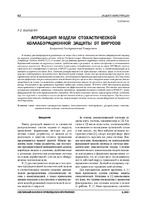| dc.contributor.author | Шарыкин, Р. Е. | |
| dc.coverage.spatial | Минск | ru |
| dc.date.accessioned | 2022-01-04T13:23:41Z | |
| dc.date.available | 2022-01-04T13:23:41Z | |
| dc.date.issued | 2021 | |
| dc.identifier.citation | Шарыкин, Р. Е. Апробация модели стохастической коллаборационной защиты от вирусов = Approbation of the stochastic group virus protection model / Р. Е. Шарыкин // Системный анализ и прикладная информатика. – 2021. – № 4. – С. 62-70. | ru |
| dc.identifier.uri | https://rep.bntu.by/handle/data/108865 | |
| dc.description.abstract | В статье рассматривается реализация на языке Java модели стохастической коллаборационной защиты от вирусов, разработанной в рамках модели Распределенных Объектно-Ориентированных Стохастических Гибридных Систем (РООСГС), и ее анализ. Целью работы является апробация модели стохастической коллаборационной защиты от вирусов в условиях, приближенных к реальным, на пути к внедрению ее использования в реальном окружении. Излагается методика трансляции спецификации системы на языке SHYMaude, предназначенном для спецификации и анализа РООСГС в рамках переписывающей логики, в соответствующую реализацию алгоритма на языке Java. Система разворачивается на виртуальных машинах, вирус и система оповещения моделируются стохастически. Выделяется ряд метрик, таких как время до насыщения вируса, доля зараженных узлов по достижению насыщения, максимальная скорость распространения вируса. Для получения оценок выбранных метрик используется метод Монте-Карло с вычислением доверительных интервалов. Анализ проводится на основе сигмовидного графика распространения вируса по времени в присутствии системы защиты. Реализуются два протокола передачи сообщений между узлами, TCP/IP и UDP. Исследуется влияние типа протокола и сопряженных с ним издержек на эффективность системы защиты. Для оценки потенциала уменьшения издержек, связанных с деталями протокола, проводится анализ исходной модели РООСГС, модифицированной для моделирования таких издержек. Исследуется влияние других параметров модели, необходимых для перехода к следующим шагам внедрения данной модели в практическое использование. Предлагается иерархический подход к обобщению системы, позволяющий сделать систему масштабируемой на большое количество узлов. | ru |
| dc.language.iso | ru | ru |
| dc.publisher | БНТУ | ru |
| dc.title | Апробация модели стохастической коллаборационной защиты от вирусов | ru |
| dc.title.alternative | Approbation of the stochastic group virus protection model | ru |
| dc.type | Article | ru |
| local.description.annotation | The article discusses the implementation in Java of the stochastic collaborative virus defense model developed within the framework of the Distributed Object-Based Stochastic Hybrid Systems (DOBSHS) model and its analysis. The goal of the work is to test the model in conditions close to the real world on the way to introducing its use in the practical environment. We propose a method of translating a system specification in the SHYMaude language, intended for the specification and analysis of DOBSHS models in the rewriting logic framework, into the corresponding Java implementation. The resulting Java system is deployed on virtual machines, the virus and the group virus alert system are modeled stochastically. To analyze the system we use several metrics, such as the saturation time of the virus propagation, the proportion of infected nodes upon reaching saturation and the maximal virus propagation speed. We use Monte Carlo method with the computation of confidence intervals to obtain estimates of the selected metrics. We perform analysis on the basis of the sigmoid virus propagation graph over time in the presence of the defense system. We implemented two versions of the system using two protocols for transmitting messages between nodes, TCP/IP and UDP. We measured the influence of the protocol type and the associated costs on the defense system effectiveness. To assess the potential of cost reduction associated with the use of different message transmission protocols, we performed analysis of the original DOBSHS model modified to model message transmission delays. We measured the influence of other model parameters important for the next steps towards the practical use of the model. To address the system scalability, we propose a hierarchical approach to the system design to make possible its use with a large number of nodes. | ru |

